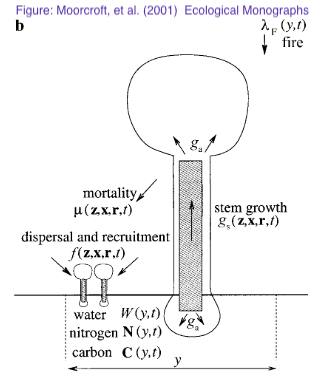Page Not Found
Page not found. Your pixels are in another canvas.
A list of all the posts and pages found on the site. For you robots out there is an XML version available for digesting as well.
Page not found. Your pixels are in another canvas.
About me
This is a page not in th emain menu
ED2 is a spatially implicit vegetation model. It keeps track of individual plant water, carbon, and energy fluxes and can scale to whole ecosystems. And More! Explore the github, or check out publications from the ED2 community. 
Summer 2019: I team up with the Boston NASA develop node to explore how land use, remotely sensed environmental varibles, and tick borne disease reports relate to one another. Check NASA Develop projects here.
Evaluating the interactions between fire and plant invasions spanning a gradient in fire management, invasive plant distribution and abundance, and climatic conditions across the southeastern U.S.
The Predictive Ecosystem Analyzer. It’s a central toolbox & network for developing, diagnosing, and using ecosystem models. Check it out 
Published in Ecosphere, 2018
Foundation species are locally abundant and uniquely control associated biodiversity, whereas dominant species are locally abundant but are thought to be replaceable in ecological systems. It is important to distinguish foundation from dominant species to direct conservation efforts. Long‐term studies that remove abundant species while measuring community dynamics have the potential to (1) aid in the identification of foundation vs. dominant species and, (2) once a foundation species is identified, determine how long its effects persist within a community after its loss. Long‐term data on ant assemblages within two canopy‐manipulation experiments—the Harvard Forest Hemlock Removal Experiment (HF‐HeRE) and the Black Rock Future of Oak Forests Experiment (BRF‐FOFE)—provide insights into how ant assemblages change and reassemble following the loss of Tsuga canadensis or Quercus spp. Previous research documented foundation species effects on ants in the HF‐HeRE for up to four years after T. canadensis loss. Six additional years of data at HF‐HeRE presented for the first time here show that removal of T. canadensis resulted in taxonomic and some measures of functional shifts in ant assemblages that persisted for ten years, further supporting the hypothesis that T. canadensis is a foundation species at Harvard Forest. In contrast, ant assemblages at BRF‐FOFE varied little regardless of whether oaks or other tree species were removed from the canopy, suggesting that Quercus species do not act as foundation species at Black Rock Forest. Deer and moose exclosures within each experiment also allowed for comparisons between effects on ants of foundation or dominant tree species relative to effects of large herbivores. At HF‐HeRE, effects of T. canadensis were stronger than effects of large herbivores on taxonomic and functional diversity of ant assemblages. At BRF‐FOFE, in contrast, effects of Quercus species were weaker than effects of large herbivores on ant taxonomic diversity and some measures of ant functional diversity. These findings illustrate the importance of distinguishing between the roles of irreplaceable foundation species and replaceable dominant ones in forested ecosystems along with other drivers of biodiversity (e.g., herbivory).
Recommended citation: Record, S., T. McCabe, B. Baiser, and A. M. Ellison. 2018. Identifying foundation species in North American forests using longterm data on ant assemblage structure. Ecosphere 9(3):e02139. 10.1002/ecs2.2139 https://doi.org/10.1002/ecs2.2139
Published in Frontiers in Ecology and Evolution, 2019
Spatial processes often drive ecosystem processes, biogeochemical cycles, and land-atmosphere feedbacks at the landscape-scale. Climate-sensitive disturbances, such as fire, land-use change, pests, and pathogens, often spread contagiously across the landscape. While the climate-change implications of these factors are often discussed, none of these processes are incorporated into earth system models as contagious disturbances because they occur at a spatial scale well below model resolution. Here we present a novel second-order spatially-implicit scheme for representing the size distribution of spatially contagious disturbances. We demonstrate a means for dynamically evolving spatial adjacency through time in response to disturbance. Our scheme shows that contagious disturbance types can be characterized as a function of their size and edge-to-interior ratio. This emergent disturbance characterization allows for description of disturbance across scales. This scheme lays the ground for a more realistic global-scale exploration of how spatially- complex disturbances interact with climate-change drivers, and forwards theoretical understanding of spatial and temporal evolution of disturbance.
Recommended citation: McCabe, T. D., & Dietze, M. C. (2019). Scaling Contagious Disturbance: A Spatially-Implicit Dynamic Model. Frontiers in Ecology and Evolution, 7(March), 1–17. https://doi.org/10.3389/fevo.2019.00064 https://doi.org/10.3389/fevo.2019.00064
Published:
Tempest McCabe, Aaron Ellison, Serita D. Frey, Alexandra R. Contosta, and Sydne Record. 2015. Community Level Response to Soil Warming and Nitrogen Addition in Temperate Forests. Ecological Society of America Conference, Baltimore, MD. Poster Presentation.
Published:
T.D. McCabe, E. Cowdery, and M.C. Dietze. December 2016. Validating the Ecosystem Demography 2 Model for Southern Pine Forests. North American Carbon Program and Ameriflux meeting, Bethesda, MD. Poster Presentation
Published:
T.D. McCabe, S.L. Flory, and M.C. Dietze. December 2016. Integrating invasive grasses into carbon cycle projections: Cogongrass spread in southern pine forests. Ecological Society of America meeting, Portland, OR. Poster Presentation
Published:
.D. McCabe, E. Cowdery, and M.C. Dietze. December 2016. Validating the Ecosystem Demography 2 Model for Southern Pine Forests. American Association of Geographers conference, Boston, MA. Poster Presentation.
Published:
T.D. McCabe, S.L. Flory, and M.C. Dietze. December 2017. Integrating invasive grasses into carbon cycle projections: Cogongrass spread in southern pine forests.Annual Meeting of American Geophysical Union, New Orleans, Louisiana. Oral Presentation.
Published:
T.D. McCabe and M.C. Dietze. December 2018. Scaling contagious disturbance: a spatially-implicit dynamic model. Annual Meeting of American Geophysical Union, Washington, DC. Poster Presentation.